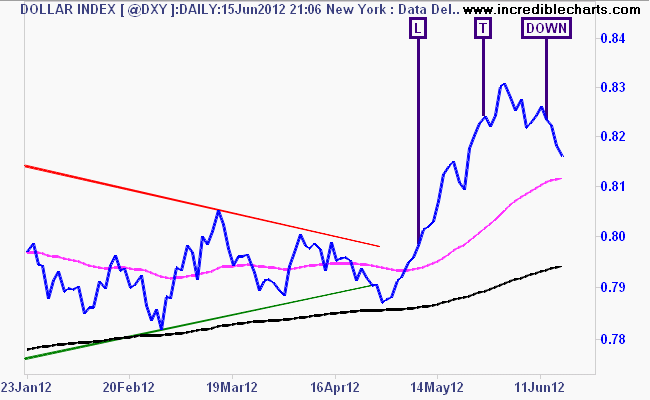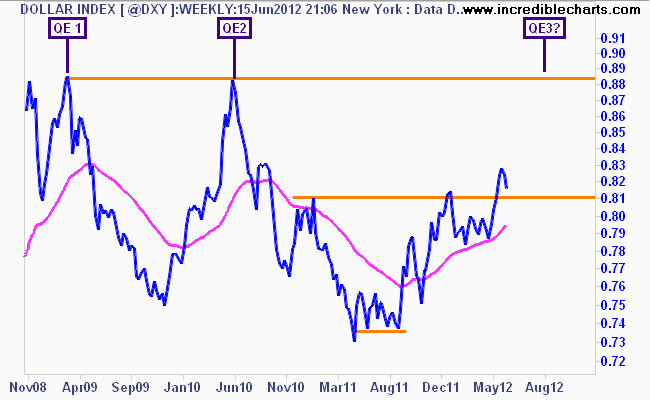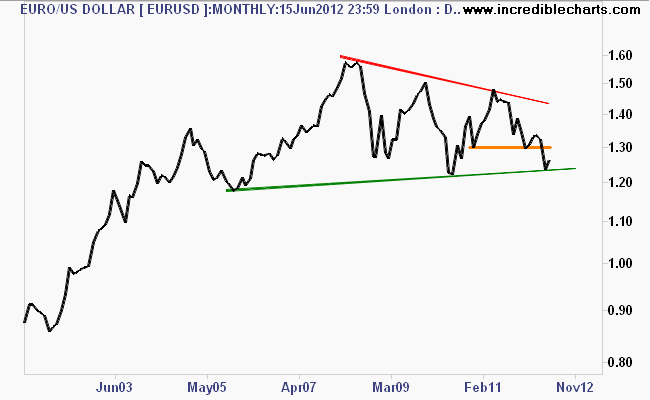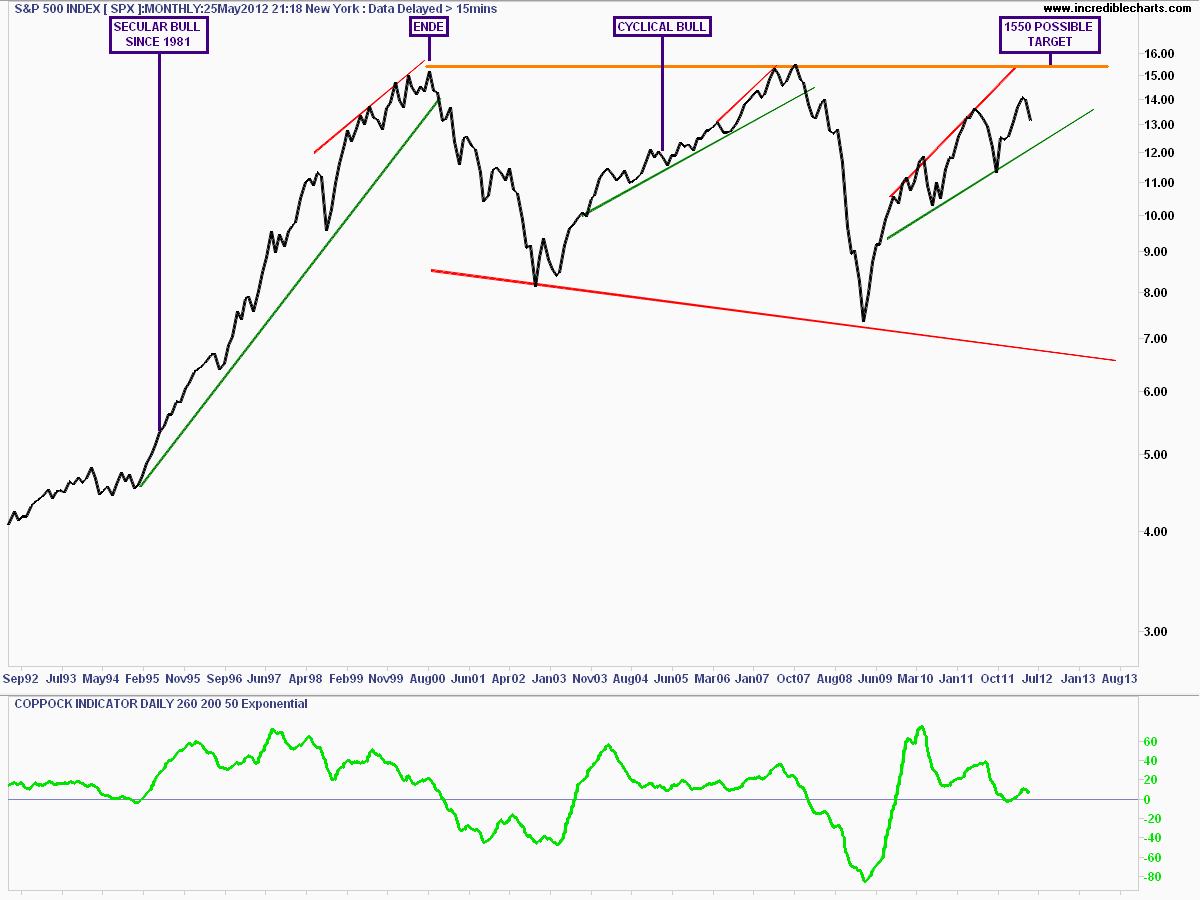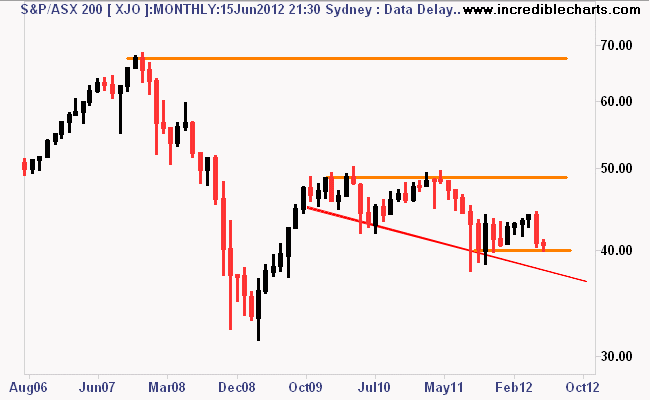
So where have the markets gone this week? Past the daily noise and headlines, this weekly chart heavy post will examine the major markets (debt, commodities, currencies then shares) with the Australian investor in mind.
This will be an important Trading Week to read for two reasons.
First, this weekend we will see the Greeks – founders of modern democracy – go to the polls to decide their fate. Never before has a small nation had such a huge impact on the world – so will say the journalists and analysts who don’t understand history. If I had my way, a history degree (with a minor in realpolitik) would be mandatory before starting any journalist or economic degree….at least the fiction they weave will then have some historical basis.
On Wednesday, and probably in response to how world markets will be impacted by that event, coupled with the recent slowdown in CPI and industrial production, the US Federal Reserve will meet and decide on whether to engage a new round of monetary easing – QE3, or known as “milky wilkies” around the MB/MA office.
If the expected decision occurs, we will see a new rally, as the markets take another heroin hit, which should pick up steam on the other side of the northern hemisphere summer. Commodities, and hence AUD, equities will go up (but mainly US and Europe, then Asia, and Aussie in the rear on a nominal basis), bonds, VIX and USD down. Risk on, risk off as Mr Miyagi would say.
Welcome to the Great Volatility, where both your optimism and pessimism to risk needs to be managed. Oh the other reason – this is my last Trading Week in its current form and timeslot. You’ll know more next week….
Currencies
As always, check out the US Dollar first. For new readers (and this column is growing in views, many thanks) the US Dollar Index (DXY) is the best way to view this, although it doesn’t include the AUD, we’ll come to that shortly.
In previous weeks analysis, I contended that the DXY had topped, and likely on its way down to 81 points. I had tightened my position/hedging system and have been scaling back USD exposure since Tuesday this week as you can see on the chart below:
This does not mean I’m out of USD – no fricking way – it just means the level of USD hedging (I use the USD ETF) is being scaled back after above the usual level on 8th May (see “L” for long signal)
I’ve always said that I believe it needed to go to “88-89 points level before a third trigger of monetary easing is pulled“. Looks like I was too optimistic because if we get that trigger next week, it will slump as it has in each case of QE in previous years:
This is a very easy barometer for risk – i.e your share portoflio – to read, particularly on weekly charts. Remember, “risk-on” means capital flows away from USD denominated assets, like US Treasuries and cash towards “risk” assets like shares and commodities, and vice-versa.
If the DXY falls below its 200 day moving average (the pink line on the chart above) on a weekly basis, probably around 81 points, that risk markets will rally hard. I’m already getting positioned for that, but as I said above, you need to keep a hedge somewhere. USD and VIX are the best bets IMO.
Euro (EUR/USD) – the”golden” currency is bouncing nicely off the support as outlined on the monthly chart, which I always look at first:
Can it get back above resistance around 1.30 key level as it has on previous monetary injections (Euro makes up 57% of the DXY)? The Euro has bounced back this week, in response to the Spanish bank bailout, but instead of going long the EUR/USD pair, I triggered a hedge trade, going short the EUR/AUD. I’ve overlaid the short term moves in the daily chart below (AUD in green):
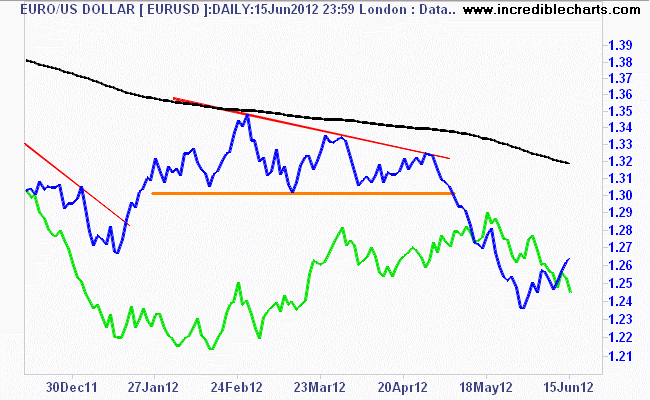
Note the weight of the 200 DMA (black line) on the Euro – I said last week that “it would take a breakout above 1.32 – only likely on a new LTRO or EuroBond Mk 1 or QE3 IMO (sorry for the acryonms) – for a new uptrend to emerge“. At the moment, the current bounce is more likely naked short positions being unwound before the Greek elections result. I am not considering a long Euro trade until that breakout key level is met, having had a short bias to the Euro since last August last year.
Aussie (AUD/USD) saw a continuation of last week’s bounce this week, and we are now back to parity for the risk proxy of the world. Before this week I did pick a deceleration pattern for a short term position, if I was still trading my very short term system that is. I had a long signal on Thursday 7th June at 99.05 for those keeping score/interested about my short term system (not for the faint of heart or bad at math)
My longer term hedging system has a short bias, but has no positions for now.
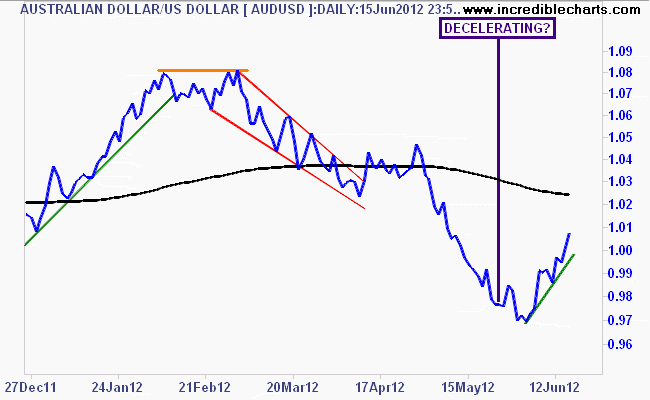
Looking beyond the short term moves, lets put current price action into context. The weekly chart clearly shows the AUD has bounced off support at the 96 cent key level, which is important for 2 reasons; first, as the lower support level in the medium term price action after the liquidity led breakout from QE2, and second – of no real importance, just interesting observation, the high it reached in the 2003-2007 risk bubble:
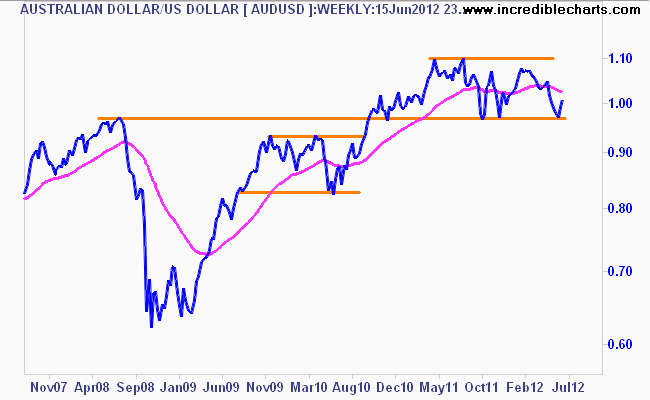
This is a fairly easy market to understand. If risk stays “on” expect the Aussie to be rangebound, but with a bullish bias, between 96 cents and 110 cents against the USD. This means a fall below 96 cents (on a weekly basis, ignore short term gyrations) would require a “gloomy” situation realised, either internally with a breakdown in perception of the strength of the domestic economy, or a broader risk-off mood in the rest of the world.
We are not a safe haven. I’m sure those who say we are dont look to the left of that chart above (or ignore that little blip in September 2008).
Gold (USD) are we finally seeing a sustained move back to the upside in the only “clean” currency left? Gold finished above $1625USD last night, my key level for an upside breakout, although I am still wary that this is not a “clean” break.
Let’s place the short term moves in context with the daily chart first, which clearly shows the weakness (inability to breach 200 DMA or series of lower highs from late February) Apologies for the candlesticks, hope that doesn’t turn you off, but it is needed to explain the short term stuff, then I’ll explain the longer term trend:
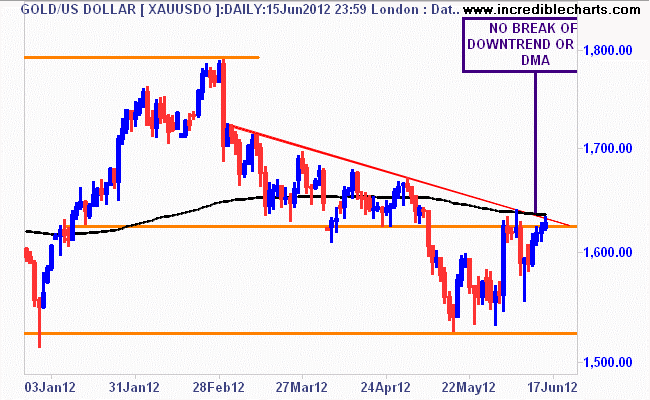
I chose the $1625/$1525 key levels with the latter easily verifiable by the support line touched by the mid-May low, but this also goes back to the mid September 2011 overshoot as well. This is solid support, that if breached would mean a large breakdown in price. The higher level is not so clearly defined – I would prefer even higher (say $1630 in line with the 200 DMA, but this is also the same breakout level required for the LTRO-led rally in early January.
This weekly chart is more illustrative of potential price moves:
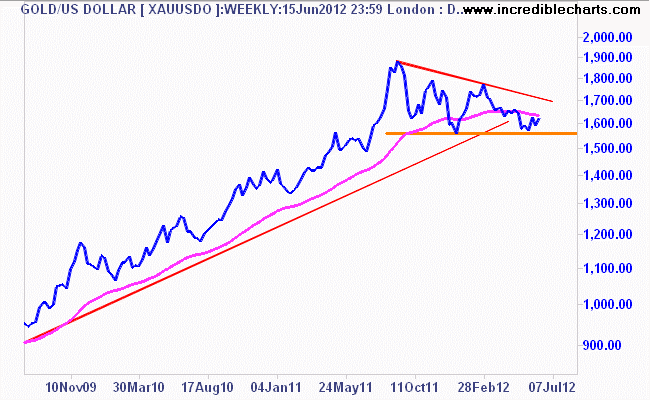
Gold remains in a secular bull market, but has obviously had a big pause or reset since the big risk correction of last year. This has been of greater magnitude than the “first” Greek induced debt crisis in May 2010 and in volatility, is as big as the GFC, although the downside has been much less this time around, which speaks volumes, IMO.
In the medium term, my position system is not yet long, but given the events likely to transpire over the next week, a small long position (via a call option) is warranted. This could break out swiftly on any QE announcement.
I’m keeping my direct hedge/exposure to gold (using the GOLD ETF, which is hedged in AUD terms) the same for now, but a bullish bias is creeping in, particularly for AUD gold:
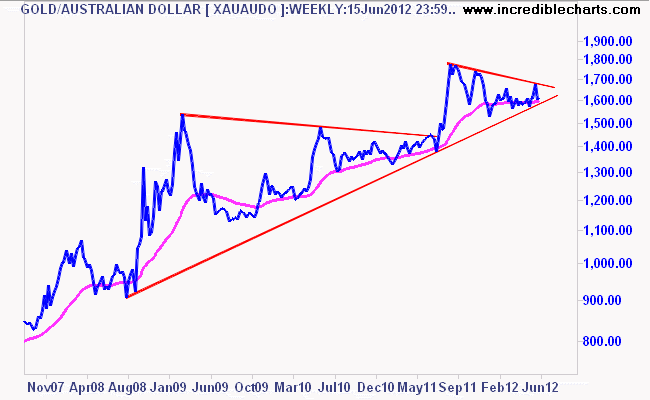
Commodities
CRB Index. The other great barometer for Aussie stocks, the CRB Commodities Index still looks weak, but I sense a bottom is forming, at least in the short term, which is guided by my position system which tightened its short recently and is about to be taken out at the 274 level, probably a wise move in this environment!
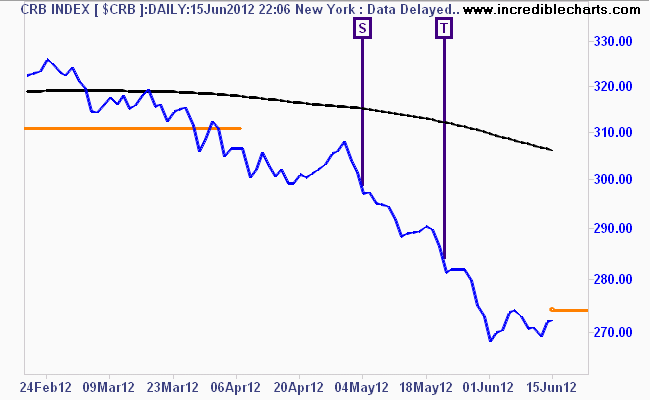
Commodities are hugely oversold, as speculators took positions that a global economic slowdown is more than likely, but also retreating on general risk concerns (which moves commodities up and down further than the underlying fundamentals. Shhh. Don’t tell anyone I said that)
What makes this different to previous post-GFC liquidity led moves is the breakdown in the CRB has been far worse, probably because the last move was far, far overbought – hence the reason your super account has looked terrible in the last year or so. Thank your fund manager for not being underweight BHP/RIO.
It would take a move above support at 295 and onwards past 330 for a sustainable risk-on rally, which Australian “holes” stocks will follow. The doom would be a very short live dive to lows experience in the post-GFC breakout levels.
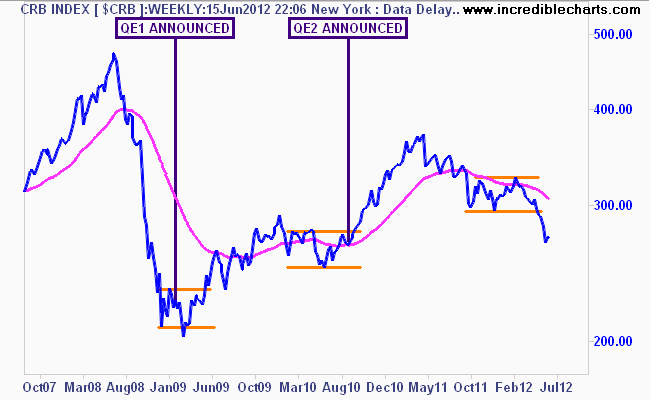
ICE Brent Crude – I continue to be wrong about crude! Crude has continued to fallen beyond where I expected it to bounce and in the short term is at its lowest point since January 2011. This is good news for commuters and truck drivers obviously, particularly in the AUD can stay strong. However, my position system is well tight and a bounce back above $101USD per barrel would set things moving again IMO:
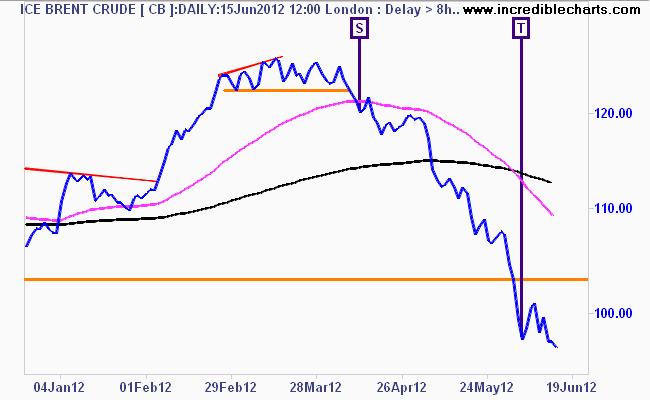
The weekly chart below shows that Brent has now broken its trendline from the post GFC low (reflecting the secular trend within oil prices). I’ve overlaid WTI Crude as well – looks messy, but it does show the nearly parallel moves between the two markers.
Its quite obvious that the QE2 surge was unsustainable, but are we overcooking it to the downside now because WTI crude hasn’t broken its trend either? I’m waiting for stimulus signals before I would load up on OOO ETF’s again…as I think many others who are watching the same charts are!
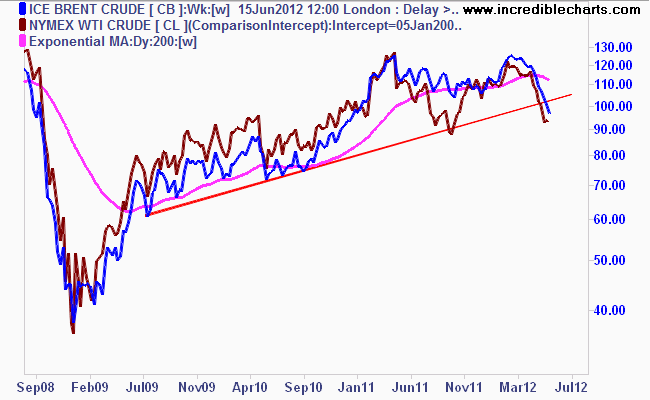
Stocks
S&P500 – the broader US market has been in a cyclical bull market since March 2009 – check my podcast here for the full monthly/secular explanation or my post here on labelling markets. Here is the monthly chart explaining those moves since the end of the secular bull market in 2000 – its full size, so click on to expand and see my notes:
The key mover of risk markets around the world – the perception of how well the US economy is doing – is seeing signs of pessimism, which means stocks will go up.
Confused? Yep – because the US economy is slowing down – although still growing – and share prices have recently corrected (by just under 10%, nothing really), the market EXPECTS the US Fed to step in and save the day (because the US government or opposition will do nothing about it).
Last night we had contracting industrial production numbers for May, plus the Empire State Manufacturing Survey slumping to almost negative, following last week’s very poor non-farm payroll numbers. Yet all US markets went up by about 1% or so…
I posed the question last week – is this cyclical bull market over? Here are 2 reasons why this is probably not the case. First, the medium term technical picture says the bull remains, unless we breach the trendline from the post-GFC low, touched during Greece Crisis Mk 1 and 2 at just over 1200 points:
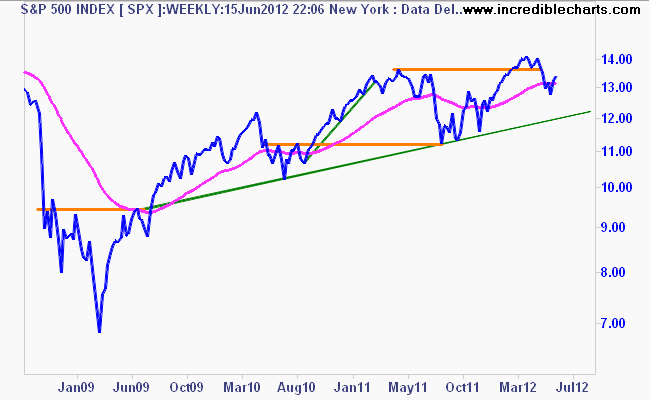
We could still have downside volatility to the 1210ish level, but the trend remains intact. The 2nd reason is my short hedge is about to be taken out, with the current stop loss just below 1350 points:
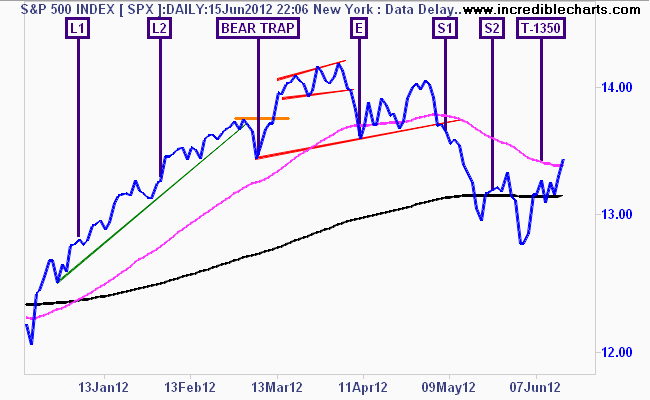
I did suggest that the current move below the 200DMA could be the start of another trap – and it appears it may be a bear trap, as the bulls seem to be gaining the upper hand. One should be careful remaining short in a market on the edge of getting liquidity from a central bank determined to rebuild balance sheets, which is why, as always, portfolio allocation and risk management matters more than getting a direction call right (I’m still copping flak for a wrong call for some reason? Strange, particularly as it comes from someone who has admitted they’ve NEVER owned shares/property…that’s a big glass house to be throwing stones through.)
Oxygen thiefs aside, the important key level to watch here is 1365 points for the current bounce to sustain, and then a monthly close above 1405 for the cyclical bull market to remain strong.
S&P/ASX200 (XJO) – finally to our local market, which has now officially moved NOWHERE in four weeks:
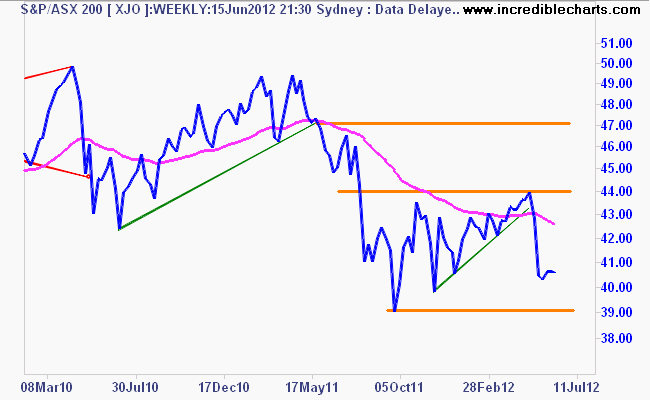 This has “bottom” spray painted on it, but not carved in stone, unless you only watch daily charts that is. Short term traders are looking for a breakout above 4100 points (but they should be trading individual shares instead of the index IMO)
This has “bottom” spray painted on it, but not carved in stone, unless you only watch daily charts that is. Short term traders are looking for a breakout above 4100 points (but they should be trading individual shares instead of the index IMO) Note the key levels:
- resistance at 4400 points – the previous high of the rally and the level the market must breach to turn any short term rally into a sustained bear market rally
- the next resistance at 4700 points, the level at which, if the market rallies, most of those who bought in the last 12 months will sell and get out IMO
- support at 3900-4000 points – the previous low of the correction – which must be maintained if we are to see any new cyclical bull market
The last level more clearly on the monthly chart, which remains in a secular bear market, moving in accordance with historical percentage and time.
If that key level is breached the trajectory is likely to be the trendline from the previous monthly lows, and indeed, the will of so many investors and baby boomers (who have yet to see a positive return over the last 4 years, if they still remain in a non SMSF).
For comparison, let’s look at the Shanghai Composite, where the spray cans are out too, as this is firming as a possible bottom as well:
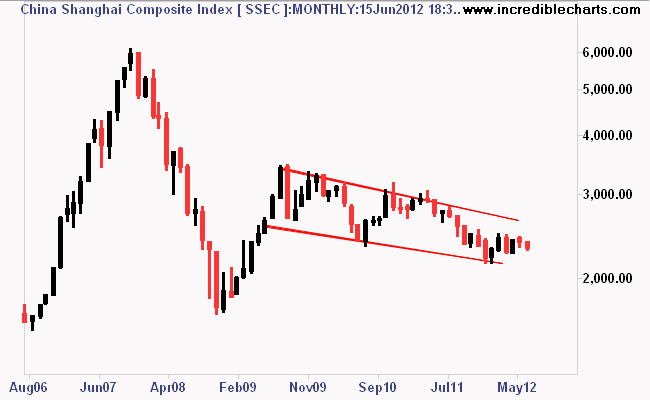
In the medium term, I’m looking at the key levels of 2400 points on an upside breakout (above the 200DMA) and 2250 points on the downside for a continuation of their secular bear market. We’ve already had two bull traps (thanks GB for your help there) – are we about to see another one?
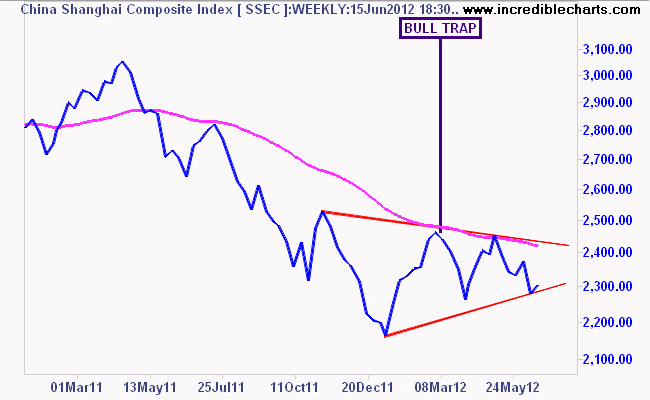
Thanks for reading folks – I’ll be back next Saturday with a preview of what’s to come with the change to Trading Week. Have a safe week and remember to manage your risk!
Disclaimer: The content on this blog should not be taken as investment advice. All site content, including advertisements, shall not be construed as a recommendation, no matter how much it seems to make sense, to buy or sell any security or financial instrument, or to participate in any particular trading or investment strategy. The authors have no position in any company or advertiser reference unless explicitly specified. Any action that you take as a result of information, analysis, or advertisement on this site is ultimately your responsibility. Consult someone who claims to have a qualification before making any investment decisions.
